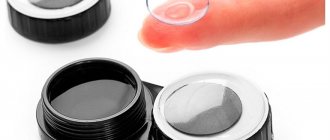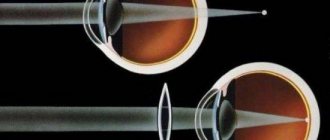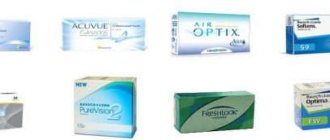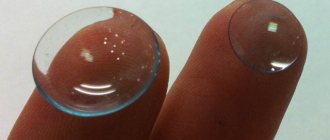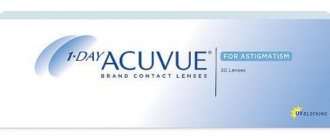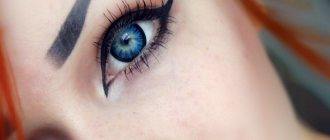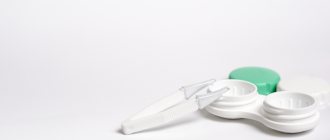Selection options
What criteria should be taken into account when choosing contact lenses?
If you decide to change your glasses to contact lenses, then your first step is to make an appointment with an ophthalmologist. Using specialized equipment, he will tell you the main parameters that you need to focus on when choosing.
The ophthalmologist determines:
- eye diameter,
- radius of curvature,
- axis,
- dioptres.
Be sure to inform your consultant at the optical store about these parameters. Additionally, you can consult with an ophthalmologist on all questions that arise related to the use of lenses, their care, proper storage, wearing regimen, etc.
2.
Rating of the best
Currently, many companies produce lenses for vision correction; they differ in price category and various parameters. But people suffering from poor vision should not skimp when choosing lenses; the main thing is to choose a quality product.
List of the 5 best brands
- Acuvue OASYS - produces lenses of different types that supply sufficient oxygen to the cornea,
- Proclear - are amazingly refined, do not create discomfort, the demand is for daily lenses from this manufacturer,
- Tutti Premium are colored eye lenses that not only perfectly correct vision but also deliver cosmetic results,
- PureVision – lenses for monthly wear are popular, easy to use, affordable in quality and price,
- Focus Air Optix Night & Day Aqua - designed for round-the-clock vision correction, high quality and can be worn without taking it off for 1-2 months.
In conclusion, we can only say that if we choose lenses ourselves or with the help of an ophthalmologist in the right way, then we will certainly remain satisfied and will be supporters of contact vision correction.
Types of lenses
Deciding on the type of contact lenses
The first thing you need to decide when choosing contact lenses is the problem that they should solve. Depending on this, they distinguish:
Classic
The most common group of contact lenses prescribed by ophthalmologists in 65% of cases. They have only one optical zone, which is selected individually (taking into account the state of your vision). Classic lenses are used only for the correction of refractive pathologies: myopia or farsightedness, regardless of the patient’s age.
Multifocal
They have several zones that differ in optical power. This allows you to see objects located at close, intermediate and far distances. They are usually prescribed upon reaching 40-45 years of age, since it is at this age that a decrease in the elasticity of the lens is observed. The largest number of optical zones is 3. Multifocal lenses are the best choice for age-related vision impairment.
For correction of astigmatism
The main feature that distinguishes them from classical and multifocal lenses is their spherocylindrical shape. It has different optical powers horizontally and vertically. This allows you to correct astigmatism along the desired meridian and additionally correct refractive errors (myopia/farsightedness).
3.
Hardness level
Soft or hard lenses?
The next step is choosing the material from which your contact lenses will be made. The comfort of wearing them and the need for getting used to them depend on this.
Soft
They are made from hydrogels and silicone gels. Main advantages: they allow much more oxygen to reach the cornea of the eye, are comfortable to wear and easy to put on. Typically, soft contact lenses are prescribed for farsightedness, nearsightedness and moderate astigmatism.
Hard
Their base is dense silicone. Rigid lenses are not very comfortable, but in a number of situations they are irreplaceable (for example, with age-related farsightedness, keratoconus, severe astigmatism). Their advantage is durability. Hard lenses increase visual acuity due to the fact that they always retain their original shape.
4.
First fitting
You need to wash your hands thoroughly and then follow these steps:
- After rinsing the lens in a special solution, you should place it on your index finger and bring it to your eye, pushing back the lower eyelid with the middle finger of the same hand.
- The other hand should lift the upper eyelid.
- While looking straight ahead or upward, place the lens on your eye and make sure it is pressed against the surface of your eye. It should be put on so that all its edges are pressed equally against the surface of the eye.
- Lower your eyes and blink to adjust the lens.
To remove a contact lens you need to:
- prepare fresh solution for storage;
- pull back the lower eyelid, open the edge of the lens and pinch it with your fingers, pull down;
- the optics can also be removed by pinching - you need to place your finger on the surface of the lens;
- pull it towards the eyelid, pinch it and carefully remove it.
Wearing mode
How long can you wear lenses?
You independently choose which contact lenses to buy: daily or with a planned wearing period, which can range from 14 days to 1 year (depending on the type). Ophthalmologists recommend buying daily lenses because they are very thin, imperceptible, and do not require special care. Their only but important drawback is their high cost.
If your financial resources are limited, opt for scheduled replacement lenses. Keep in mind that they need systematic cleaning and disinfection, otherwise plaque will form on their surface. If you are looking for the best option in terms of price-quality ratio, we recommend choosing lenses for 1 month.
Note! When purchasing extended-wear lenses, do not forget to immediately choose a multifunctional solution designed for cleaning, disinfecting and storing them.
Another criterion that is important to consider when purchasing is the mode of use. Some lenses will need to be removed before going to bed, while others can be used at night (continuous wear is limited to 7 and 30 days).
5.
Complications from wearing lenses
Expired products cannot be 100% cleared of accumulated plaque. Even if you rub your monthly lenses every day, cracks and microscopic scratches will still begin to appear on them. These “wounds” accumulate pathogenic organisms that can cause serious harm to the health of the visual apparatus.
Using “expired” products invariably leads to itching and irritation. Plaque on the surface of the eyepieces can not only lead to the appearance of various pathologies. Particles of dust and dirt get clogged into microcracks, and every day less and less oxygen reaches the eyes. And this is one of the main conditions for the proper functioning of the organ of vision. As a result, “dry eye” syndrome develops, burning and stinging appears.
Color contact lenses
Change eye color in 1 minute
Colored lenses whose diopters are 0 are often called decorative. They are used for cosmetic purposes to change the shade of your eyes. Often used by artists, professional makeup artists and models. Today they are available to everyone who wants to experiment with their appearance and try unusual looks.
Types of decorative lenses:
Tinted
They are used to enhance the natural color of the eyes. They make it brighter, noticeable and attractive. They are usually chosen by owners of light eyes, since the matrix of tint lenses is only slightly tinted, and the natural color of the iris can be seen through it.
Colored
They radically change the color of the eyes: from black to light blue, from gray to dark brown, etc. Judging by the reviews, the iris does not show through the matrix of such contact lenses. On the surface of the products there is a pattern that imitates the iris and gives the eyes a natural look.
With pattern
They are usually chosen for photo shoots or theme parties. Lenses with a pattern imitate cat eyes and are also used to create images of vampires, witches, etc. The only drawback is low oxygen permeability, so it is recommended to wear them no more than 5 hours a day.
6.
Humidity
Determining the hydrophilicity index
The comfort of wearing contact lenses depends on the level of humidity (hydrophilicity). The higher this indicator, the better for your vision. The level of hydrophilicity is indicated on the packaging and usually ranges from 38 to 78%.
Well-moisturized contact lenses do not cause discomfort, irritation or redness. When choosing products for round-the-clock use, make sure that they have a high level of hydrophilicity.
7.
For a child
How to choose contact lenses for a child?
Modern lenses give children complete freedom of action, which is especially important for their full development. They do not narrow the angle of vision, and therefore do not affect the clarity and brightness of the image, unlike standard glasses.
You can use contact lenses from 10-12 years of age. The main thing is to explain to your child how to put them on, take them off and store them correctly. The best choice for children will be daily lenses, which are characterized by high levels of hygiene and safety.
From 14-15 years old, you can switch to products with a prolonged period of validity: 14 or 30 days. At this age, the child can independently care for the lenses, so there will be no problems with their use.
8.
Price
How much do quality lenses cost?
The price range for daily contact lenses varies from 20 to 150 rubles per package. The cheapest, but at the same time high-quality products are offered by Soflens Daily Disposale from Bausch & Lomb. Pack of 30 pcs. from this brand will cost you 600 rubles.
The price for regular wear lenses will be slightly lower. For example, two-week products will cost 75 rubles. for 1 piece One-month lenses cost from 65 to 600 rubles. for 1 piece If you decide to opt for semi-annual products, then they will cost you at least 210 rubles. for 1 piece
Decorative lenses are more expensive. Depending on the brand and intensity of the shade, their price will range from 350 to 1,500 rubles. The cost of lenses with a pattern reaches 2,000 rubles. and higher.
9.
Let's go shopping
When the diagnosis has been carried out and you have an ophthalmologist’s prescription for the purchase of lenses, you can buy them in special stores or on the Internet. Each package has a special marking, and when buying lenses, you need to understand this mysterious abbreviation.
Explanation of symbols on the packaging.
Before purchasing, you should read the labeling on the packaging. The three required characteristics are always designated the same:
- BC - radius of base curvature;
- DIA - diameter;
- D or PWR - optical power (diopters).
In addition, the packaging must contain the following parameters:
- Exp —expiration date;
- LOT - lot number;
- Sterile - designation of the pregnancy of the product;
- CT —thickness;
- SE 0086 - certificate;
- half the sun - the presence of a UV filter;
- RXOnly - sales only by prescription.
Manufacturers of quality optics
It is quite difficult to say which contact lens manufacturer is the best. All of them use innovative technologies in their production, most of them use high-quality materials that are comfortable and safe for the eyes.
But still, among all the diversity we can highlight:
- Wohlk is a German company that produces high-quality lenses under the Carl Zeiss brand.
- Sauflon Pharmaceuticals Limited is an English company that has been on the market for four decades. Specializes in the production of contact optics and care products.
- OK Vision is a Korean company that produces contact optics for a wide range of consumers.
- Maxima Optics is a large international company that produces lenses and lens care products.
- Johnson & Johnson Vision Care Inc is a global leader in contact optics.
- Interojo is an international company that combines advanced technologies and therapeutic effects in its products.
- Cooper Vision is an American company that has been producing contact lenses for half a century.
- CIBA Vision is a leader in the production of optical products, including contact lenses.
- Bausch & Lomb is the largest American company that produces a wide range of ophthalmic products.
- Avizor is a Spanish company that produces contact lens care products.
- Alcon is a global manufacturer in the ophthalmic field. This American company has been providing people with vision correction products for more than 50 years.
As for Russian companies producing contact optics, they still occupy a modest place in the market. But at the same time, the products of these companies are in demand. Firstly, they have affordable prices, secondly, Russian companies offer lenses of large diopters (-20 - +20), thirdly, quality control of Russian products is more strict.
Leading Russian companies producing contact optics:
- Concor produces soft contact lenses from domestic and imported materials.
- Octopus - produces soft contact optics and hard gas-permeable models.
- Optimedservice produces traditional lenses with a wear period of 6 months.
- Doctor Optik - produces tint and cosmetic lenses designed to disguise various eye defects.
Where can I buy
Decide on an optical store.
You can choose and buy contact lenses in a chain optical store, a specialized vending machine (lens machine) or an online store. We strongly do not recommend buying them in dubious places, because the condition of your vision depends on it.
If this is your first time buying lenses, it is better to buy them at one of the regular optical stores. Their prices are a little higher, but you can talk to a consultant and find out his opinion about a particular company.
For those who are buying contact lenses more than once and know which products are ideal, we recommend placing an order in an online store or using a vending machine. Unfortunately, the network of lens machines is small, so you can only find them in large cities.
10.
Doctor in an optician's salon
Many optical stores, usually in large cities, provide vision testing services directly in the store. In most cases, pre-registration is required for vision testing and lens fitting. Therefore, this procedure is not much different from visiting an ophthalmologist in a clinic or private medical institution in the corresponding field.
Don't expect your first consultation to go quickly. There is a difference between a full eye examination and a vision test.
When visiting the nearest optical salon that provides services of this kind, have a few hours to spare.
Brand
Select a brand
Lenses for vision correction are represented by many Russian and foreign companies. Among the most famous manufacturing brands:
Air Optix
Excellent lenses, the key advantage of which is high breathability. This means that they do not cause discomfort or a “sand in the eyes” effect even with long-term use.
Acuvue
The most common lenses in Russia are produced by the Johnson & Johnson brand. They ensure that the required level of hydration is maintained even with prolonged wear. Both clear and decorative lenses from this brand are on sale.
PureVision
A feature that distinguishes hydrogel contact lenses from this company is their rich blue tint. This does not affect your vision at all, but they look very beautiful and unusual.
Proclear
Contact lenses of this brand are very thin, do not interfere with air circulation and therefore are extremely comfortable to wear. The best choice for those who have recently started using them. The unique Proclear coating on lenses keeps them hydrated for a long time.
Which contact lenses are best to choose?
The question is complex, because in the optical industry market there are many worthy manufacturers of contact correction products.
The leaders include the following brands:
- Acuvue from Johnson & Johnson - they can attract and retain moisture to the maximum, transmit large volumes of oxygen to the cornea, have a low elastic modulus and optimal thickness - due to this, the eyes feel great in the lens throughout the day.
- AIR OPTIX® and Dailies from Alcon - they are absolutely not felt on the eyes when worn, due to the patented ultra-smooth surface technology sewn into them. This means you don’t even feel like you’re wearing lenses!
Please treat your health as carefully and consciously as possible, do not take unnecessary risks and select lenses only in reliable places and only from professionals. We have only one eye, and the implants instead of the original ones are damaged, until, alas, you put them in.
Come to Ochkarik - a wide selection of contact correction products and more awaits you. A cozy, friendly atmosphere and good mood are guaranteed!

